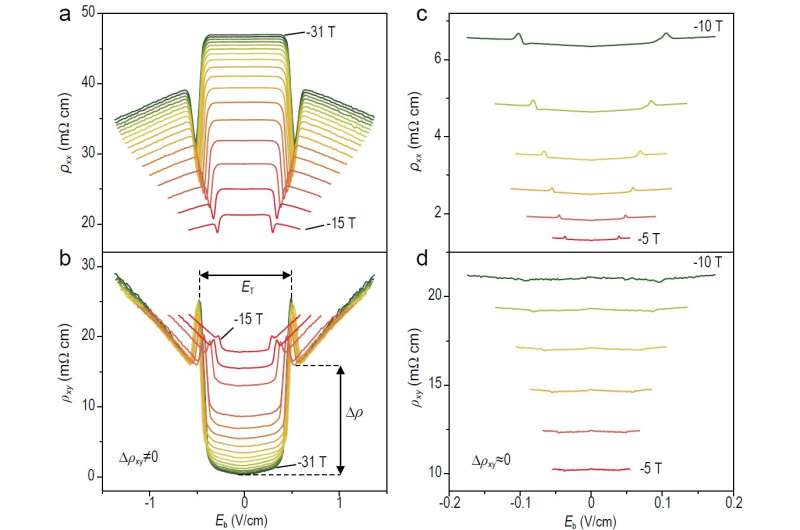The evolution of longitudinal resistivity ρxx and transverse resistivity ρxy as a function of biased electric fields in different magnetic fields. Credit: Science China Press
Combining topological states of matter with strong electron correlation promises many exotic phenomena such as charge fractionalization, excitonic instability, and axionic excitation. Layered transition-metal pentatellurides ZrTe5 and HfTe5 were found to be close to an accidental topological semimetal phase with low carrier density. Even in a relatively low magnetic field, they can form highly degenerated Landau levels and dramatically enhance the correlation effect of Dirac electrons therein. Therefore, these pentatellurides are good candidates for tunable correlated topological states. This phenomenon was examined in a recent study led by Prof. Faxian Xiu and Prof. Cheng Zhang from Fudan University.
Earlier quantum transport studies on pentatellurides uncovered a bulk quantum Hall state in magnetic fields, while its physical origin remains controversial. In the current study, Xiu and Zhang take a different approach, nonlinear transport, which tracks the evolution of bias-dependent resistivity in magnetic fields. Generally, the D.C. resistivity of conventional materials is in the linear regime, independent of the applied electric bias. However, in certain phases such as charge and spin density waves, electrons trapped in the local potential well can be released by a relatively small bias voltage and then strongly modify the resistivity values.
By measuring the longitudinal and transverse differential resistivity at different biases, Xiu and Zhang directly probe the density wave transition induced by magnetic fields. Surprisingly, they find that beyond the previously proposed 1D density wave, the density wave also persists along the in-plane direction. In addition, the insulating state at higher magnetic fields can be suppressed by the bias voltage as well, which puts a strong constraint on the mechanism of the metal-insulator transition.
Together with theorists, the authors construct the phase diagram of HfTe5. With the application of magnetic fields, electrons in HfTe5 firstly become a 3D density wave state, and then become localized by the magnetic freeze-out effect. These frozen electrons can be gradually re-activated into mobile states above a threshold electric field, which results in the activated conduction in both longitudinal and transverse directions.
These results demonstrate clear evidences of the emerging many-body effects of Dirac electrons induced by magnetic fields and establish dilute pentatellurides as a clean and tunable platform to explore novel collective-mode dynamics in correlated topological physics.
More information: Cheng Zhang et al, Magnetic-field-induced nonlinear transport in HfTe5, National Science Review (2021). DOI: 10.1093/nsr/nwab208
Provided by Science China Press























